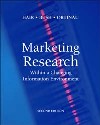 |  Marketing Research: Within a Changing Information Environment, 2/e Joseph Hair,
Louisiana State University
Robert Bush,
University of Memphis
David Ortinau,
University of South Florida
Descriptive Research Designs: Survey Methods and Errors
Chapter SummaryExplain the advantages and disadvantages of using quantitative, descriptive survey research designs to collect primary raw data.
Some of the main advantages of using survey designs to collect primary raw data from respondents are ability to accommodate large sample sizes' generalizability of results; ability to distinguish small differences between diverse samples groups; ease of administering and recording questions and answers; increased capabilities of using advanced statistical analysis; and abilities of tapping into latent factors and relationships. In contrast, the main disadvantages of survey research designs tends to focus on potential difficulties of developing accurate survey instruments; inaccuracies in construct and scale measurements of factors; and limits to the depth of the data structures. In addition, researchers can lack control over long time frames and potentially low response rates, among other problems.
Discuss the many types of survey methods available to researchers. Identify and discuss the factors that drive the choice of survey methods.
Survey methods are generally divided into three generic types. One is the person-administered survey, in which there is significant face-to-face interaction between the interviewer and the respondent. Second is the telephone-administered survey. In these surveys the telephone is used to conduct the question-and-answer exchanges. Computers are now used in many ways in telephone interviews, especially in management functions, data recording, and telephone-number selection. Third is the self-administered survey. In these surveys, there is little, if any, actual face-to-face contact between the researcher and prospective respondent. The respondent reads the questions and records his or her answers. Most of the emerging technology survey methods are self-administrated, although some, such as virtual reality, will require human intervention.
There are three major factors affecting the choice of survey method: situational characteristics, task characteristics, and respondent characteristics. With situational factors, consideration must be given to such elements as available resources, completion time frame, and data quality requirements. Also, the researcher must consider the overall task requirements and ask questions like, "How difficult are the tasks?," "What stimuli will be needed to evoke responses?," "How much information is needed from the respondent?," and "To what extent do the questions deal with sensitive topics?" Finally, the researchers must be concerned about the diversity of the prospective respondents, the likely incidence rate, and the degree of survey participation. Maximizing the quantity and quality of data collected while minimizing the cost and time of the survey generally requires the researcher to make trade-offs.
Explain how the electronic revolution is affecting the administration of survey research designs.
With the increasing advances in telecommunication and computer technologies, numerous new, fast techniques are available to researchers for collecting primary raw data from people. The range of new techniques continues to grow and includes such methods as computer-assisted telephone interviewing methods; fully automated self-administered techniques; and electronic mail, fax, and Internet surveys. There is little doubt that the time requirements of collecting data will significantly decrease with these new methods.
Identify and describe the strengths and weaknesses of each type of survey method.
It is important to remember that all methods have strengths as well as weaknesses. No single method is the best choice under all circumstances. Nor is the information researcher limited to a single method. Innovative combinations of survey methods can produce excellent results, as the strengths of one method can be used to overcome the weakness of another.
Identify and explain the types of errors that occur in survey research.
The researcher needs to evaluate the errors in the research results. All errors are either random sampling errors or nonsampling errors. By far the greatest amount of error that can reduce data quality comes from nonsampling (or systematic) error sources. Three major sources of error are respondent error (i.e. nonresponse errors and response biases); measurement and design error (i.e., construct development, scale measurement, and survey instrument design errors); and administrative errors (i.e., data processing, interviewer and sample design errors). In survey research, systematic errors decrease the quality level of the data being collected. |
|



 2003 McGraw-Hill Higher Education
2003 McGraw-Hill Higher Education